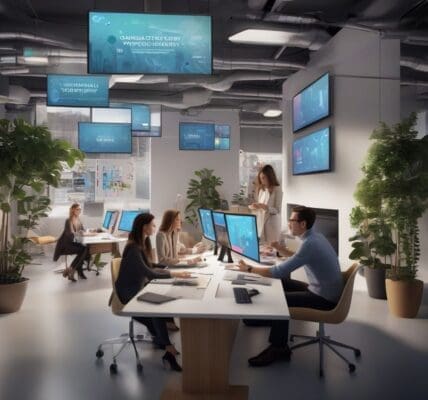As we move into 2024, it’s crucial for businesses to recognize and act on emerging trends that shape how they connect with their customers. The insights derived from the 2024 Trends in Customer Experience & Commerce report by S&P Global provide illuminating perspectives that can significantly enhance customer engagement and operational efficiency. Here are the top ten trends from the report that could influence your strategy going forward.
1. The Rise of Generative AI (GenAI)
An overwhelming 87% of organizations currently utilizing GenAI plan to maintain its use due to its transformative potential in customer-facing departments, including marketing (53%) and customer service (42%). With GenAI capabilities such as personalized responses and anticipatory service, businesses can enhance the customer journey while simultaneously reducing operational costs. Given that 57% of organizations are increasing their IT budgets to invest in GenAI, this trend cannot be overlooked. Companies should evaluate opportunities to integrate GenAI across all customer touchpoints, not solely in support roles, to realize its full potential.
2. Embedded Commerce is Expanding
The shift towards embedded commerce—where consumers can purchase directly within platforms like social media, streaming services, or live events—is gaining momentum. With 43% of consumers becoming unresponsive to brands if checkout processes are overly complex, simplifying this journey is essential. For instance, companies like TikTok and NBCUniversal are already implementing shoppable features that eliminate barriers to purchase. Integrating one-click checkouts and personalized promotions within these platforms can amplify customer engagement and reduce cart abandonment rates.
3. Optimizing Content Supply Chains
As the demand for diverse content types and formats increases, businesses need to establish efficient content supply chains that stretch from ideation to performance measurement. Research indicates that a well-structured feedback loop allows brands to optimize messaging in real-time, resulting in more relevant and engaging content for consumers. As 72% of businesses plan to invest in user-generated content over the next year, utilizing robust content strategies becomes imperative for maintaining authenticity and fostering trust among consumers.
4. Advanced Customer Data Platforms
Data-driven insights have never been more critical. Companies require platforms that not only store but also analyze customer data to offer a holistic view of customer interactions. A staggering 75% of respondents have noted that aligning product design with customer feedback enhances the overall experience. By employing a data-driven platform, organizations can collect real-time feedback, address pain points swiftly, and fine-tune offerings, ensuring a smoother customer journey.
5. The Shift to Composable Architectures
In the tech landscape, many organizations are favoring composable architectures over traditional headless systems. Composable systems enable flexibility and adaptability, allowing organizations to modify digital experiences without extensive overhauls. Only 14% of businesses are leaning towards headless architectures, while the majority prefer solutions that marry IT agility with front-end usability. This flexibility is vital for companies aiming to adapt quickly to market changes and consumer demands.
6. The Rise of Embedded Communication Tools
Traditional customer service models are evolving with the rise of embedded communications. These solutions provide real-time engagement across various platforms, yielding a more fluid customer experience. With consumers interacting through multiple channels simultaneously, integrating chat, voice, and video capabilities directly into digital interfaces is crucial for staying competitive. By employing conversational AI to handle routine inquiries, businesses can enhance customer satisfaction and free up human agents for more complex issues.
7. Evolution of Account-Based Marketing (ABM)
ABM’s role is expanding. No longer limited to lead generation, ABM is now focusing on nurturing long-term customer relationships post-sale. The need for customer success management is on the rise, with respondents in a recent study indicating a growing preference for hiring customer success managers over sales personnel. This shift ensures continued engagement with customers, maximizing upsell opportunities and reinforcing brand loyalty.
8. Financial Services Transformation
The competition between traditional banks and fintech providers continues to shape the financial landscape. Consumers expect a seamless, digital-first experience, pushing banks to rethink their existing models. By investing in technology that offers personalized, real-time services, banks can retain customers while competing effectively with agile fintech businesses.
9. Understanding Unique Consumer Behaviors
A keen understanding of consumer preferences is vital, especially in markets like Germany, where thorough research, customer reviews, and convenience weigh heavily in purchasing decisions. With a significant portion of consumers opting for online platforms that aggregate multiple sellers, brands must cater to these expectations through effective digital strategies and seamless shopping experiences.
10. Leveraging Augmented and Virtual Reality (AR/VR)
Consumers are increasingly inclined toward engaging shopping experiences provided by innovative technologies such as AR and VR. By facilitating express shipping and incorporating these technologies, businesses can enhance the shopping journey and boost customer satisfaction.
The trends highlighted in the S&P Global report stress the importance of adapting to technological advancements and changing consumer behaviors. Aligning strategies with these insights will ensure that businesses not only meet customer expectations but also capitalize on emerging opportunities. Remaining proactive in adopting these trends will position your business favorably in a competitive landscape.












